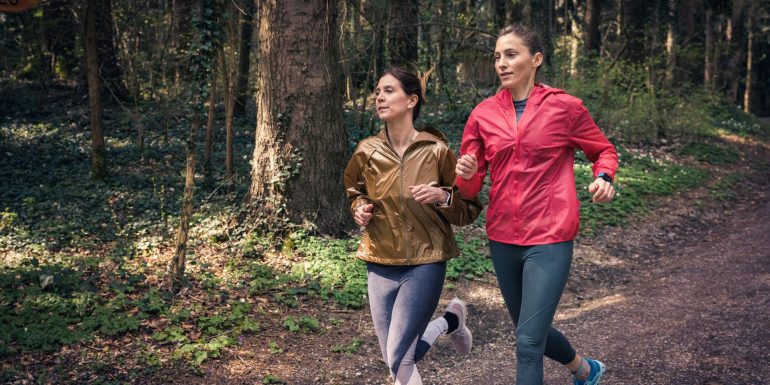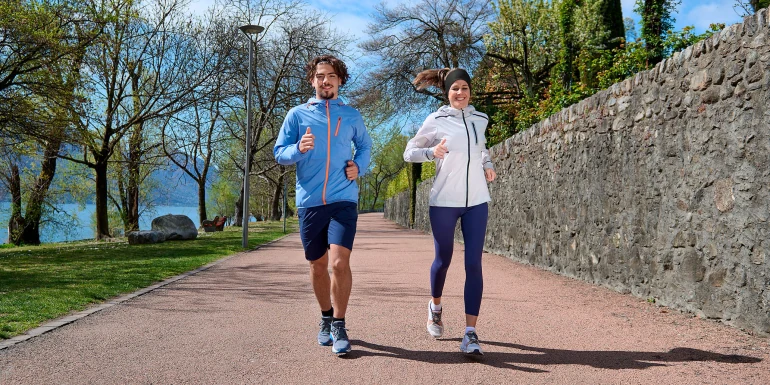
Good running technique
A safe running style avoids stresses and even injuries. It also makes jogging more efficient – faster and with less energy expenditure. How to avoid the typical beginners’ mistakes and improve your running technique with the ABCs of running.
The Swiss are crazy about running, with around a fifth of Swiss people going jogging regularly. The benefits are clear: you don’t need expensive equipment, you can be flexible in terms of time and you don’t need a coach. Nevertheless, it’s worth taking a closer look at running technique – especially for beginners – and observing certain tips before sprinting off.
Jog more efficiently with the ABCs of running
The ABCs of running – also called Running School – includes a series of running exercises to help make running easier, faster, safer and injury-free. Integrate exercises, such as ankling, into your regular jogging sessions. Just 10 minutes of the ABCs of running can sustainably improve your running technique, making your running style smoother and putting you at less risk of accidents. Incidentally, the ABCs of running will also help you with other types of sport that involve a lot of running, such as football or hockey.
Integrate the exercises into the first half of your workout, when you've already warmed up a bit:
Ankling
Ankling improves ankle elasticity, posture and foot-strike coordination. Raise your knees up to a 70-degree angle during exercise, making sure you’re taking lots of small, dainty steps in quick succession. If you feel like you’re not getting anywhere, you’re performing the exercise correctly. Important: point your toe with each step, and land on your forefoot.
High knees
High knees are a variant of ankling, but your knees are brought up higher – to just below hip height, if not further. Each step is still short, and this exercise is performed at maximum pace. Activate all your core muscles, and make sure to tread lightly and not to lean your core backwards. This exercise works the hip flexors and improves upper body posture.
Butt kicks
This is a great workout for the calf muscles! When running, raise each heel to the corresponding buttock, alternating as you go, and make sure that each foot is on the ground for as short a time as possible. Land on the ball of your foot or on your whole foot.
Ankle workout
This ankle workout is an important exercise for optimising your running technique: it works the calf muscles, improves ankle joint mobility and strengthens the ankles. Your ankles will become more stable, helping you to avoid injuries such as sprains. For this exercise, place your feet next to each other and push each heel off the floor without lifting your foot, taking each in turn.
High-knee skips
For these high-knee skips, go back to your childhood and skip for a short distance. Push yourself off the ground hard with the leg in question and swing your arms up to shoulder height. Avoid leaning backwards.
Sideways running
Criss-cross sideways running improves mobility in the hips, thereby reducing strain injuries. Start with your right leg: lift your knee up and bring it in front of the left leg, then behind it, and so on. To work out the other leg, change the direction you’re running in. Rest your hands on your hips, if you like.
Move. Earn points. Benefit.
Helsana+ rewards your dedication, whether you’re jogging, walking or hiking. Simply download the Helsana+ app, connect your tracker watch or smartphone and start collecting points. Your activity will earn you valuable Plus points that you can convert into cash, vouchers or donations. You can collect over CHF 300 per year.
Avoiding typical beginners’ mistakes
If you have never been a runner, or if you haven’t run for a long time, you should observe the following rules, besides improving your running technique:
1. Don’t overdo it
Spurred on by good intentions, beginners often want to jog too fast or too often. This can quickly lead to stresses and strains. The rule of thumb as far as speed goes is: “run without panting”.
2. Warm up
Warming up is an important part of training to reduce the risk of injury. Muscle and tendon injuries, sprains or over-stressing are much more likely if you don’t warm up. Ideally, you should always walk a few minutes before jogging – first at a normal walking pace, then faster. After five minutes, switch to your own pace.
3. Take it easy on your stomach
Don’t jog on a full stomach; eat 2 to 3 hours beforehand and ensure you pick easily digestible foods. Only eat small snacks, such as a piece of fruit, immediately before jogging. After your training, a good mix of proteins and carbohydrates is the order of the day, whether in liquid or solid form.
4. Make sure to take in enough liquid
Practising sport is a sweaty business. It’s essential that you compensate for this loss of fluid – before and after running. Start your workout well hydrated and drink 200 to 400 millilitres of water half an hour before jogging. If you run for less than 60 minutes, you don’t need to drink any water during your workout.
5. Invest in good equipment
You don’t need to buy any expensive equipment for running, but a good pair of shoes is an absolute must to avoid stresses, strains and injuries. When buying running shoes, it’s worth drawing on the expertise of a specialist shop.
Need more tips on getting started with running? Read the most important basics – from breathing technique to our training plan for beginners.
If you have ambitious running goals and want to prepare for a half marathon, you should do so with the help of a serious training plan. You need systematic training over a long period of time to be able to cope with this 21-kilometre run. A half marathon takes between 1.5 and 2 hours. A run of this length is a great strain on the body, so you need to be fit enough to handle it. Most experts recommend 10 weeks of running training. There are many reputable training plans available online for half marathons, covering different durations, for beginners and advanced runners, and some with useful nutrition tips.
And finally, one more piece of advice
Even if your focus is primarily on your legs and feet when jogging, and though running technique plays an important role, it’s a good idea to strengthen your core muscles, too! In dynamic sports, a stable core is one of the most important factors in preventing injuries. The more stable your torso muscles are when running, the better you can coordinate your arms and legs, and the safer your overall running style. So, it’s worth doing targeted strength training or Pilates one day a week to strengthen your abdominal, back and buttock muscles.

The sports scientist (MSc in Rehabilitation and Prevention in Sport) provided the editorial team with advice and input for this article.


Newsletter
Find out more about current health issues every month and get all the information you need about our attractive offers from all Helsana Group companies * delivered by e-mail to read whenever it suits you. Our newsletter is free of charge and you can sign up here:
We did not receive your information. Please try again later.
* The Helsana Group comprises Helsana Insurance Company Ltd, Helsana Supplementary Insurances Ltd and Helsana Accidents Ltd.
